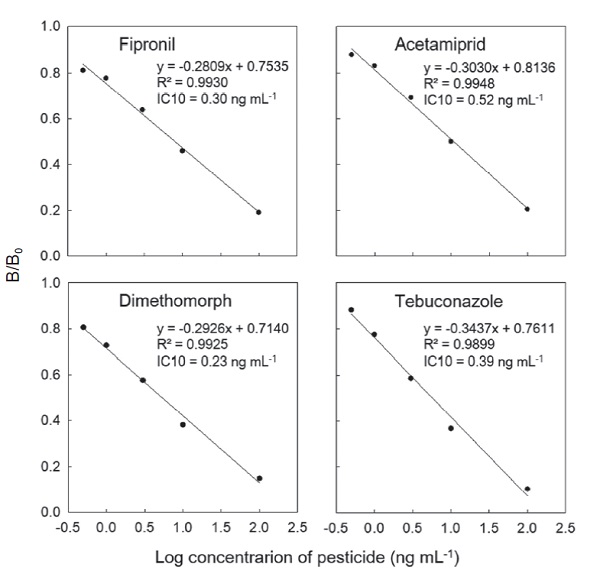Current issue

Author:Shu-Chen Chang*, Hsuan Shentu, Ching-Hua Kao, Shu-Chin Lo, and Ming-Yao Chiang
Abstract:
In order to evaluate the rapid screening efficiency of pesticide immunoassay, a commercial direct competitive enzyme-linked immunosorbent assay (dcELISA) was conducted to detect the residues of fipronil, acetamiprid, dimethomorph, and tebuconazole in agricultural samples. The detectable range and the detection limit of these four pesticides by this dcELISA kit were 0.5–100 ng mL-1 and 0.23–0.52 ng mL-1, respectively. Agricultural samples such as komatsuna, carrots, green tea, pumpkin, and yam were chopped and each added with fipronil, acetamiprid, dimethomorph, and tebuconazole to 50 ng mL-1. After extraction and dilution, residual pesticides were detected by dcELISA. The recovery rates of these four pesticides were 73.1–123.6%, 61.7–111.1%, 72.5–102.3% and 67.9–113.9%, respectively, which indicated immunoassay has high sensitivity and a good recovery rate. It takes only one hour from sample extraction to result interpretation, and is adequate for rapid screening of pesticide residues for agricultural products with high risk or known pesticide application records.
Key words: Direct competitive enzyme-linked immunosorbent assay (dcELISA), Fipronil, Acetamiprid, Dimethomorph, Tebuconazole
Download:![]() PDF Links
PDF Links
- 1. Development of Tractor-Mounted Seedling Transplanter for Sweet Potato
- 2. Synergistic Effect of Additional Gas on the Toxicity of Phosphine to Sitophilus oryzae and Sitophilus zeamais (Coleoptera: Dryophthoridae)
- 3. Effects of Temperature and Solar Radiation on Growth Traits and Plant Elements in Purple Leafy Sweet Potato
 Submit your manuscript
Submit your manuscript
 Guide for authors
Guide for authors